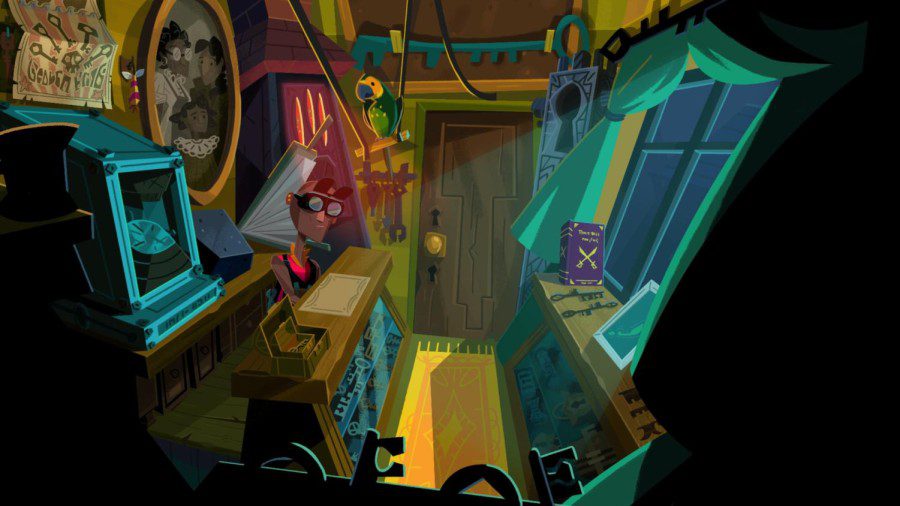Review: ‘Return to Monkey Island’ is a nostalgic pirate adventure game
The latest revamp in the “Monkey Island” series recovers the glory of the patient point-and-click. “Return to Monkey Island” is available on Nintendo Switch, macOS and Windows.
Return to Monkey Island, the long-awaited follow-up to the legendary Secret of Monkey Island and Monkey Island 2: LeChuck’s Revenge by Ron Gilbert’s Terrible Toybox, in collaboration with Devolver Digital and Lucasfilm Games, coming 2022. (Courtesy of Terrible Toybox)
October 21, 2022
Point-and-click video games were particularly popular in the ‘90s. As the name suggests, players point and click on different elements of the games’ environments in order to interact with them and solve puzzles. One of, if not, the most popular point-and-click games was “The Secret of Monkey Island.”
The game is often praised for its colorful characters, witty dialogue and clever puzzles. While it did spawn several sequels, it’s hard to imagine such a game in this year’s gaming landscape — the slower paced, slightly archaic gameplay often associated with point-and-click games doesn’t quite resonate with the flashy gameplay standards set by more contemporary games. Yet, “Return to Monkey Island” proves that the series can indeed work today without sacrificing what made it great in the first place.
“Return to Monkey Island” puts players in the shoes of wisecracking pirate Guybrush Threepwood as he tries to uncover the secret treasure of Monkey Island. The game has very basic foundations that give way to well thought-out puzzles. There’s very little that players can do aside from interacting with or picking up items and talking with other characters. Rather than coming from the skillful execution of these simple mechanics, however, progress is tied to how players consider and take into account all aspects and details of the surrounding environments, characters and items. Players are encouraged to explore each setting, talk to each character and pick up each item they come across in “Return to Monkey Island.”
For example, Guybrush encounters a locked door early in the game. If the player had previously explored the town on Mêlée Island, they’d know there’s a locksmith that can make a key for them. Unfortunately, the locksmith needs the lock’s serial code, which is too small to see with the naked eye. Thankfully, if the player has already met the town’s cartographer, they’d notice that he wears a monocle — the player needs to steal it to see the lock’s serial number. From there, Guybrush can get the serial code to make the right key that unlocks the door.
It’s refreshing to see a game that requires little to no prowess in its gameplay mechanics, but still provides complex scenarios that reward the player for intuitive thinking. This way, players of all skill levels can comfortably pick up “Return to Monkey Island” and still feel engaged.
One of the most striking differences in gameplay between point-and-click games of the ‘90s and more contemporary games is in the overall pacing of gameplay. The much slower, methodical pace of the “Monkey Island” games doesn’t line up with the faster industry standards of today. Thankfully, “Return to Monkey Island” has made a few concessions that help keep the gameplay from slowing to a crawl.
The most obvious change introduced is the fact that players can now hold down a button to increase Guybrush’s movement speed. This is a more-than-welcome addition, as players can now sprint from one area to the next without needing to endure the almost comically slow walking speed often seen in point-and-click games.
“Return to Monkey Island,” boasts not only magnificent gameplay but also incredible comedic writing. Guybrush is an absolute joy to play as. His excitable manner of commenting on everything the player interacts with makes even the slower sections of the game that much more entertaining. The player can converse with almost any character in the game. The facetious dialogue, distinct characters, terrible puns and evolving relationships make each verbal exchange in “Return to Monkey Island” feel rich.
The game also uses a distinct angular and abstract art style that never gets boring. It’s almost as if the entire game were made out of extremely intricate paper cutouts. Each area of the game is fully realized with its unique geometry and mesmerizing hues, and the wide color palette ensures that players will have a hard time taking their eyes off the screen. It’s definitely a big departure from the pixelated look of older entries in the series, but this new style never gets in the way of itself, and instead helps keep the game fresh.
“Return to Monkey Island” is an incredible game that takes everything special about the “Monkey Island” series and revamps it to work within a more modern context. It’s a bit sad to see such a colorful and innovative genre relegated to the sidelines, while “Call of Duty” can’t even come up with new game titles. While some fantastic modern indie games such as “Thimbleweed Park,” “Roki” and “Kentucky Route Zero” are part of the point-and-click genre, “Return to Monkey Island” will hopefully shed more light on this inventive category and bring it back into the public eye.
Contact Ferris Elaraby at [email protected].


























































































































































